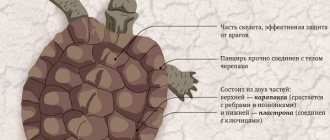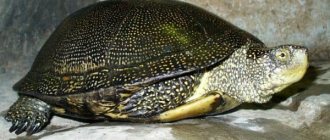The narwhal is a small toothed whale that lives in Arctic coastal waters and rivers. Its distinctive feature is a long tusk protruding forward above the mouth. Because of him, the narwhal received the nickname “unicorn of the sea.”
Narwhals and beluga whales are close relatives, together making up the family Monodontidae (narwhals) of the suborder Odontoceti (toothed whales). The name "narwhal" comes from the Old Norse words "nar" (corpse) and "hvalr" (whale). “Corpse” refers to the mottled gray coloration of the narwhal, reminiscent of the skin color of drowned sailors. The animal's scientific name, Monodon monoceros, comes from the Greek words meaning “one-toothed” and “one-horned,” respectively.
Appearance
Perhaps the most noticeable feature of the narwhal is the presence of a “tusk” that can grow up to 3 meters in length. The tusk is actually a massive fang protruding from the narwhal's upper left lip. Tusks grow mainly in males. Narwhals have only two teeth; As a rule, the left tooth erupts, but the right tooth remains undeveloped. In most females both teeth remain vestigial, however in rare cases both sexes may develop both canines. If both canines are present, the left one is always larger. All tusks are twisted in a counterclockwise spiral and have a polished end.
Photo: www.arctickingdom.com
Although many theories have been put forward regarding the primary function of the narwhal's tusk, recent observations suggest that the males use their enormous tusk to hunt fish and sense the salt level of the water in which they swim. Previously, reputable scientists, including the English naturalist Charles Darwin, believed that males use their fangs when fighting for females.
Narwhals also have three more unique physical characteristics:
- absence of a dorsal fin. Instead of a dorsal fin, narwhals have a dorsal crest. The dorsal ridge and the notches on it are unique and can be used to identify individuals.
- articulated neck. Unlike most other whales and dolphins, the narwhal has an articulated neck, rather than a rigid or fused neck. This means that the animal can move its head separately from its body.
- changes in body color with age. Narwhals are white or light gray at birth. As these toothed whales mature, the colors begin to turn darker, creating a mottled pattern. The young are bluish-black in color. Adults have a dark, spotted back and a cream-colored ventral region. As they age, they become lighter again; very old individuals become almost completely white.
Origin of the species and description
Photo: Narwhal
Narwhals are mammals belonging to the family and genus Narwhalidae - the only representatives of their genus. Narwhals are cetaceans - mammals that have been able to fully adapt to life in water.
It is difficult to establish the origin of narwhals, since their ancestors have not been found that would have a similar tusk, which grows from the head of narwhals. The closest relatives of narwhals are belugas; they have the same constitutional structure, with the exception of the structure of the oral cavity.
Video: Narwhal
Cetaceans have many similarities with artiodactyls. According to their genetic code, they are close to hippopotamuses, so it can be concluded that the ancient ancestors of narwhals were Mesonychia mammals. These animals were similar to wolves, but had paired hooves.
Mesonychia lived near the coasts and ate fish, crustaceans and mollusks. This diet forced the animals to often go into the water or live in swamps. Their bodies changed to suit the aquatic lifestyle - a streamlined body shape and compacted tails were formed. The nostrils of all cetaceans are located on the back - they perform exactly the same functions as the nose of land animals.
Interesting fact: The narwhal tusk is an amazing evolutionary phenomenon. When scientists reliably understand why these animals need it, many questions about the origin of the narwhal will be closed.
Why the narwhal does not have a dorsal fin is also an open question. Probably, due to the northern habitat, the fin was reduced - it was inconvenient when swimming on the surface, near a layer of ice. The fins of cetaceans have a fairly fragile structure, so narwhals could simply break them often on thick ice.
Size
Adult narwhals range from 4 to 5 meters in length and weigh from 900 to 1,600 kg, with males being larger than females. Newborn cubs reach 1.5 meters in length and usually weigh about 80 kg. A typical narwhal has 30-35% of its weight in fat. This layer of fat, 50 to 100 mm thick, is essential for survival in cold Arctic waters. Narwhals can also be identified by their fins, which are smaller than those of most other cetaceans and have a distinctive upward-curved tip.
Photo: Wildestanimal/Getty Images
Categories
- Rest on the waters (119)
- Aqua style (75)
- Wind of wanderings (79)
- Water treatments (31)
- Questions - Answers (45)
- Guide (76)
- Living water (134)
- Animals (106)
- Nature reserves (127)
- Health (110)
- Consultation (66)
- Seas and oceans (235)
- Thinking out loud (57)
- National Park (91)
- Need to know (302)
- News (67)
- Image of water (52)
- Lakes and Rivers (99)
- Technology Parade (97)
- Drinking water (62)
- Planet Earth (173)
- Let's talk heart to heart (176)
- Journey into history (60)
- Plants (158)
- Republic (142)
- Let's solve the problem together (100)
- Pisces (64)
- Garden (159)
- Properties of water (39)
- Wells and wells (60)
- Events (66)
- Tourism (186)
- Interests and hobbies (44)
- Physical Geography (113)
- Photo album (183)
- Flowers and blossoms (124)
Geographic range
Narwhals are found in the Arctic and Atlantic oceans. They are considered the most northern cetaceans. Narwhals can usually be found in areas between 70° and 80° north latitude. Large populations occur in northeastern Canada, Greenland and northern Russia to the East Siberian Sea. They are rarely seen on the surface, so it is likely that they are found in other places.
This is a migratory species of toothed whale. During the summer, narwhals are found in the northern Canadian Arctic, off the east coast of Greenland. In late September, most individuals begin migrating south to their winter homes in Baffin Bay. The onset of ice freezing or melting around narwhals appears to signal the need for them to migrate.
Why is the narwhal the ancestor of the unicorn myth?
Many centuries ago, these animals were the main prey of the northern peoples. Fishermen sold the tusks to traders from Europe and Asia at the most modest prices. And they, in turn, put them up for sale in their homeland, asking unimaginable money for the goods. Traders told naive buyers that these were not whale tusks, but real horns of unicorns - fairy-tale creatures from distant lands. This is how the first myths and legends about these extraordinary horses appeared.
Narwhals are one of the most amazing creatures on Earth. Now one of the main tasks of humanity is the preservation of these animals as a species. A more careful attitude towards them will increase their survival rate, and hence the birth rate.
Habitat
The narwhal lives primarily in open, deep Arctic waters. He spends time at different water depths; When hunting, narwhals tend to dive deeper and spend more time underwater. They dive to depths of up to 1,500 meters while feeding, remaining underwater for up to 25 minutes. These are some of the deepest dives ever recorded by any mammal. Narwhals are capable of repeating such dives up to 15 times a day.
However, during migration, narwhals usually dive to shallower depths, but more often. Narwhals are known to swim up to 160 km per day during migration. On average it is about 6.5 km per hour. It is noteworthy that both summer and winter narwhal locations contain deep fjords.
Description of a mammal
The narwhal is called the unicorn of the sea. He is distinguished by his unique appearance, gracefulness and developed intelligence. This is a type of mammal from the order Cetacea and the Narwhal family. Let's learn more about what the animal looks like, where it lives, what it eats, and why it is listed in the Red Book.
What does it look like
The sea animal reaches a length of 4.5 meters. Its weight is 1.5 tons. Females weigh about 900 kg. A significant part of the body is covered by a layer of fat, which protects against low temperatures.
The narwhal's head has a protruding forehead and a round shape. It does not have an upper fin. The belly of the mammal is light, the sides are dark. There are spots all over the body. The animal has no lower teeth. There are two bone formations at the top.
Males have a spiral-shaped tusk that can reach a length of 3 meters. This horn has the following meanings:
- weapon of attack;
- object to attract females.
Sometimes mammals cross their tusks to remove growths from them. Decompression sickness does not occur in animals because their blood absorbs a minimum of nitrogen compounds.
Note! The name of the sea animal comes from an Icelandic word and is associated with the coloring of the skin.
Character and lifestyle
The narwhal has long adapted to living among the ice. A thick fat layer protects it from low temperatures. Strong tusks are capable of breaking through hard surfaces. A group of animals constantly gathers near one ice hole and takes turns inhaling the air.
These creatures usually swim in small groups and communicate with each other using the following sounds:
- clicks;
- gurgling;
- moans;
- sighs.
In summer, the mammal lives in deep waters. In winter it exists in icy waters.
Important! Previously, sea unicorns gathered in huge flocks of several thousand individuals.
What does it eat?
The animal's diet is quite varied. It includes:
- cephalopods;
- crustaceans;
- fish (cod, stingray, gobies, halibut, flounder, sea bass).
For food, the animal dives to a depth of 850 m. There it eats fish that are located in the bottom area.
Sea unicorns have functional teeth that allow them to shoot jets of water and dislodge prey. The flexible neck makes it possible to capture moving fish.
Where does it live?
The mammal lives in areas of the island of Franz Josef Land, near Greenland, in the latitudes of the Arctic Ocean. The migrations of the animal depend on the direction of drifting ice. You can meet the animal at depth; it is less often seen near the coast.
The species was observed in the area of the Netherlands and Great Britain, in the White Sea, near Bering Island. In winter you can see the creature off the Murmansk coast, in the White Sea. A sea unicorn was spotted off the coast of France.
Reproduction
Animals mate throughout the year. Peak activity occurs in spring. The female carries the cub for almost 20 months. Sometimes she gives birth to two babies. The interval between reproduction is 3 years.
A baby narwhal feeds on milk for about two years. At birth he weighs approximately 80 kg. After 5 years it reaches sexual maturity.
The animal can be called a long-liver. His maximum age is 55 years. In captivity, it quickly dies due to lung diseases.
Natural enemies
Natural enemies of the species include:
- sharks;
- White bears;
- walruses.
The mammal is hunted by ferocious killer whales. They deal mercilessly with the sea unicorn. To hide, the narwhal dives very deep and hides under the covers of ice.
Arctic sharks prey on the animal's cubs; walruses attack less frequently. The polar bear catches cetaceans that poke their heads out of the water for a breath of air.
The animal's serious enemy is man. People exterminated sea unicorns for sport and bragging rights.
Attention! If a polar bear attacks a sea unicorn, other individuals begin to make sharp sounds, similar to a piercing whistle. In this way they warn other flocks.
Meaning in nature
Historically, narwhals have been a source of food for Arctic peoples. Today they serve as hosts for parasitic animals - whale lice, nematodes.
The mammal does not have a negative economic impact on humans. The sea unicorn is a living indicator of the ecosystem. It senses any climate change and is sensitive to environmental pollution.
Attention! The animal's intestines are used to make ropes, and its fat is used as lamp oil.
Communication and perception
Narwhals communicate acoustically. This species of toothed whale is capable of producing two different types of sounds:
- pulse. This type of signal typically ranges from 12 to 20 kHz. As the name suggests, it is a short, rapid sound or click. They are used by narwhals as a kind of echolocation, allowing them to effectively detect and catch prey. This type of sound is also used for spatial orientation and likely helps narwhals stay together during migration.
- whistling. Unlike a pulsed sound, a whistle is a longer signal with varying frequencies that is probably used primarily for communication. These sounds range from 300 Hz to 10 kHz.
When studying the tusk of a narwhal, about ten million nerve endings were discovered. This leads researchers to believe that the tusks have a sensory function. In 2014, scientists at Harvard Medical School found that the narwhal's heart rate increased and decreased when the tusk was exposed to high or low concentrations of salt in ocean water.
Interesting facts about the animal
Let's learn interesting facts about the sea unicorn:
- Since the 12th century, traders have sold the animal's tusks, passing them off as alicorns - the horns of the mythical unicorn. They were worth more than gold.
- The lifespan of a mammal in captivity is no more than 6 months.
- Thanks to thousands of nerve endings on the tusk, the animal is able to detect water pressure and temperature.
- A narwhal tusk is a modified tooth containing nerves. This part of the body is used as a receptor. Females have tusks that are not as large as those of the opposite sex.
- The narwhal uses its horn to force fish to the surface from the bottom.
- There are known cases of sea unicorns attacking whales. Most likely this was an accidental collision.
- The mammal does not have a fin on its back.
- A third of the animal’s total mass is fat, reaching a thickness of 10 cm.
- The narwhal will not be able to live in warm water.
- The largest tusk is 3 m long. It weighs about 10 kg.
- If the horn breaks, it will never grow back and will be sealed with a bone filling.
- According to an old belief, a piece of narwhal tusk in a glass of poisoned drink can change its color.
- Individuals are very talkative among themselves.
Freedom-loving narwhals do not tolerate captivity, so it is better to protect these amazing animals from a distance.
Do you have any questions about Narwhals or something to add? Then write to us about it in the comments, this will make the material more useful, complete and accurate.
Eating habits
A study of the stomach contents of narwhals showed that their diet is very limited and varies depending on the season. The first thing to note about narwhals' diet is that they do not feed during the summer. Examination of the narwhal's stomach contents during three other seasons showed that the animal had recently ingested food, but no dietary fiber was found in the stomach during the summer months.
In winter, narwhals remain in shallow areas of bays, where they feed almost exclusively on bottom-dwelling fish. During the Arctic summer they move into open ocean waters, so their diet expands to include other fish species such as cod and halibut, as well as squid and shrimp. In spring, the narwhal feeds mainly on arctic cod and cod. Crustaceans were also found in their stomachs, but fish and cephalopods were much more common.
Because narwhals do not have well-developed teeth in their mouths, they are thought to suck in prey and swallow it whole.
Narwhal nutritional features
The narwhal's diet consists of cephalopods, as well as small amounts of crustaceans and fish. The basis of nutrition is bottom representatives of ichthyofauna (cod, skate, halibut, flounder, gobies). The narwhal can dive up to 1 km for prey and can remain under water for quite a long time. In addition, the animal scares and stuns bottom fish with the help of its tusk.
Reproduction and development
Photo: dottedhippo/Getty Images
Male narwhals become sexually mature at approximately 8-9 years of age, while females reach maturity much earlier, at approximately 4-7 years of age. The mating season lasts from March to May. It is assumed that females choose a mate based on their tusk.
After fertilization, pregnancy lasts about 14 months, meaning the female gives birth only in June of the following year. She bears one cub at a time; twins are very rare. Narwhal babies are born tail first and begin swimming shortly after birth. Over the next 20 months, the young will be fed on their mother's rich milk. It is because of the long lactation period that female narwhals give birth on average once every three years.
Behavior
The narwhal is a social animal and is usually found in schools of six to twenty individuals, although most groups tend to number between three and eight individuals. Smaller groups usually gather during the migration season to form a flock of hundreds or even thousands of individuals.
Narwhals remain in close proximity to the ice throughout the year. There are various hypotheses about the main functions of the tusk. Perhaps males use it for competition. It can also be used to obtain food. Since most females do not have a tusk, the most likely assumption is that these are secondary sexual characteristics.
Lifespan
In the past, the lifespan of narwhals was estimated by counting the growth rings on unerupted teeth. However, the technique was later found to be inaccurate. It is generally accepted that narwhals live in the wild for about 50 years. They are among the longest-living marine mammals, despite spending their lives in some of the most dangerous environmental conditions on Earth.
In captivity, narwhals live from one to four months. Not a single capture was successful. Keeping these elusive whales in aquariums and zoos has led to tragic deaths.
Where does the narwhal live?
Photo: Sea narwhal
Narwhals live only in the cold waters of the Northern Ocean, as well as in the North Atlantic.
The places where you can most often find herds of narwhals are as follows:
- Canadian Archipelago;
- the coast of Greenland;
- Spitsbergen;
- Franz Josef Land (from 2021);
- New Earth;
- south of Great Britain (wintering only);
- Murmansk coast;
- White Sea (also only in winter);
- Bering Islands.
Despite the many areas where narwhals live, their numbers are extremely low. This scattering makes it difficult to observe narwhals, which is why even today some individuals can become victims of poachers.
Narwhals lead a herd lifestyle. They usually live at depth, being in constant motion. Together with young and elderly individuals, they travel tens of kilometers a day in search of food. Narwhals remember places where there are holes in the ice to breathe.
Two herds of narwhals meet extremely rarely - using echolocation, they determine each other’s locations and avoid meeting each other. When meeting (they occur, most often, at wintering grounds), they make greeting sounds, without conflicting families in any way.
Now you know where the sea unicorn narwhal is found. Let's see what he eats.
Do narwhals have natural enemies?
Narwhals have been found in the stomachs of Greenland sharks and walruses. Younger individuals become prey to polar bears, who wait for them near holes in the ice. Narwhals are also attacked by killer whales. Sometimes hundreds of narwhals and beluga whales become trapped by pack ice in a pool of open water.
Photo: ALAMY
Narwhals typically travel in small pods, and when pursued by a predator, they will move closer together and form a tighter group. Another defense mechanism of narwhals is their coloration, which acts as camouflage. The lighter belly helps them blend into the sky when looking up at them, while the darker mottled color on their back blends in with the ocean depths when looking down at narwhals.
Narwhal tusks are highly prized, which is why people hunt adult males. This is thought to explain why adult males tend to stay further offshore and spend less time on the surface than juveniles and females.
Narwhal (Monodon monoceros)
General characteristics. Narwhal is a medium-sized animal, the maximum body length of males is up to 600 cm (or a little more), females - about 450 cm. The body is somewhat shortened, the head is small with a highly developed fat pad, giving it a rounded, even spherical shape. The dental system is very unique.
There are no teeth on the lower jaw, and only two on the upper jaw (one on each side). In females they do not erupt, but in males the right tooth also remains hidden in the gum, and the left one is turned into a huge tusk, directed horizontally forward. Its length can reach 300 cm. The tusk is helical-shaped along its entire length.
The narwhal's coloration changes with age. Young animals have a uniform dark color, adults have a light, yellowish-gray color. Small dark spots of irregular shape are randomly scattered across the upper part of the body. Distribution and migration. It lives only in the cold waters of the Arctic basin, where it is distributed circumpolarly.
Narwhals make regular migrations, the timing and distance of which are determined by the movement of the Arctic ice edge. In the summer months, animals stay in the region of 80-85° N. sh., for the winter, along with the ice, they descend to the south. The areas of both summer and winter habitat depend on hydrometeorological and ice conditions of the year. Narwhals, as a rule, are not found in the coastal zone of our northern seas.
Narwhal (Monodon monoceros)
Nutrition. The narwhal's main food is probably cephalopods; they also eat fish. The remains of several species of squid, as well as salmon, herring, cod, stingrays, halibut and flounder have been found in the stomachs of narwhals.
Reproduction and development. Childbirth and mating can take place throughout most of the year. The length of newborns is about 150 cm. The duration of pregnancy is not established.
Behavior. Narwhals usually live in small groups, less often alone. Groups can consist of animals of different sexes and ages, only males or only females with cubs. Sometimes the group lies motionless on the surface of the sea, and then the tusks of all males are directed upward. Staying in ice is common for narwhals.
Number. The species is very rare throughout its entire range; the narwhal can even be classified as a rare animal.
Economic importance. Several hundred heads are caught annually by local residents of the Greenland coast, so narwhals have some economic importance in the life of the local population of this area. In all other places of the range, even the occasional catch of one or two narwhals is rare.
Atlas of Marine Mammals of the USSR, 1980. Text by V. A. Arsenyev, drawings by animal artist N. N. Kondakov
Meaning to people
Narwhals have traditionally been an important resource for the people of Greenland and Canada. Fat and oil were used by the Eskimos for lighting, heating and cooking. Narwhal skin, called "muktuk" by the natives, is an important part of their diet as it is rich in vitamin C. Narwhal sinews were traditionally used as thread. Their meat can be consumed by humans, but more often it is used as dog food. Narwhal tusks were originally used as spear or harpoon points, but later they proved much more useful for trade.
Photo: Paul Nicklen
In the northern parts of Greenland, many people still live the traditional Eskimo life, so the narwhal is still a very important resource for them. This lifestyle is also making a comeback in Canada, where using service dogs is more economical than snowmobiles.
Legends and beliefs about these animals
In ancient times, many people were already familiar with the narwhal, and among them it bore the name “sea unicorn.” Magicians and sorcerers attributed magical properties to narwhal tusks and added them to their potions. For a long time it was used as a ritual attribute.
Healers claimed that a decoction of ground tusk could cure any disease. These animals were constantly hunted; their tusks were exchanged for food, and sometimes even for gold. In the mid-twentieth century, narwhal hunting was banned, but this ban was not effective. Tracking the poachers was not so easy. The large territory and impassable terrain prevented this.
As a result, this issue was never resolved. The same northern peoples make their homes from the skin of this animal. It is said that narwhal fat helps with cold and prevents the body from freezing if smeared with it.
The whole family goes hunting for this animal. One person places special baits, while the other attracts the animal with characteristic sounds. This is usually done in places where there is a hole.
As soon as the animal appears on the surface of the water, they beat it with sharp objects and wait until it dies. After this, the whole family begins to pull him out of the water. As a rule, they are butchered there, since the weight of the narwhal does not allow them to carry it away entirely.
On the one hand, this is of course barbarism, and on the other hand, these people, deprived of another type of food, will simply die without this animal. To date, the population of these animals is not in danger.
How many narwhals are there today?
According to the IUCN Red List of Threatened Species, the global population of narwhals numbers approximately 123,000 adults. Narwhals are currently listed as "least concern". Although they are not currently in danger of extinction, without fisheries controls they could be at risk of extinction. The narwhal population is also declining as a result of shipping. The route of ships often intersects the migration of these toothed whales, which leads to the death of some individuals.
Climate change is also a threat to narwhals. Like most Arctic predators, narwhals rely heavily on sea ice for their survival. They use it to hide from predators and catch prey. Rising sea temperatures have led to declines in narwhal populations in Southeast Greenland.
The European Union recently banned the sale of narwhal tusks in hopes of reducing the number of animals killed by humans for their tusks.
Why does a narwhal need a tusk?
The fact is that the tusk is the most sensitive part of the whale’s body, which consists almost entirely of nerve endings. With it, he can determine the temperature, pressure of water, as well as its composition.
The tusk also has a purely practical use. During the hunt, it is with this that the whale stuns its victims, the list of which most often includes fish and octopuses. Narwhals also use their tusks to dig at the bottom and get various mollusks. There is a version that whales use it to break through the ice to breathe a little. But this fact has not yet been fully studied.
LIFESTYLE
Narwhals live in herds, the largest of which number up to 2,000 animals. Mostly they are found in related groups, but there are also herds in which animals are grouped according to gender and age. Males of the same age usually gather in groups of 8-10 animals. Narwhals are friendly marine animals. They can often be observed in the fjords along with their relatives, beluga whales. It is also interesting to watch the narwhal dozing on the surface of the icy water. The narwhal uses its convex forehead to make a hole in the ice (a hole), to which it returns from time to time if the ice crust is too thick for it in other places. A narwhal can stay underwater for fifteen minutes. In the fall, when the Arctic waters are frozen, narwhals swim south in large herds, where they spend the winter.
INTERESTING INFORMATION. DID YOU KNOW THAT...
- In the Middle Ages, people believed that the narwhal's tusk was the horn of a unicorn and attributed miraculous healing properties to it. Queen Elizabeth II of England kept the narwhal horn as a valuable relic.
- Some male narwhals (unicorns) have two tusks, the spirals on which have one direction - twist to the left. The length of the tusk can reach 3 meters. It is visible from under the upper lip and is growing all the time. Sometimes such a tusk grows in female narwhals.
- The beluga whale, which is also the only species of the genus, belongs to the narwhal subfamily along with the narwhal.
- The Old Norse word "rod" means "corpse". The narwhal, or "corpse whale", was so named because the mottled coloration of the older animals was similar to that of a corpse.











